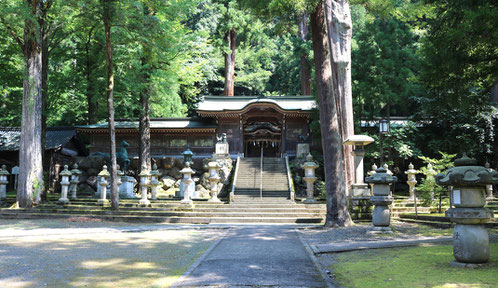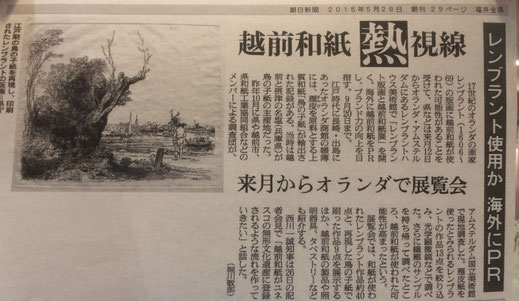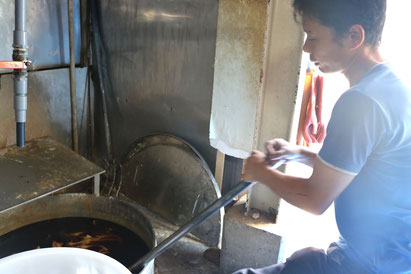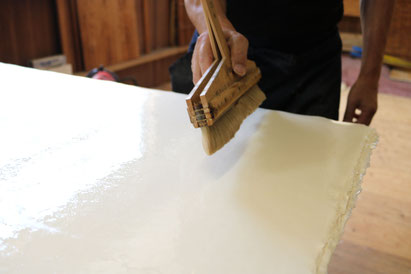- ホーム
- 喜太郎の木版画和紙とは
- 商品一覧
- オーダーメイド木版画和紙
- 無料見本帳
- ご購入の流れ
- 会社紹介
- English
- About Woodblock Print Paper
- Product Lineup
- 1. Kizuki
- 2. Hankusa (white)
- 3. Hankusa (natural color)
- 4. Hankusa Atsukuchi
- 5. Shichibukusa (white)
- 6. Shichibukusa(natural)
- 7. Torinoko Atsukuchi
- 8. Kozoshi(white)
- 9. Kozoshi (natural)
- 10. Ganpishi
- 11. Kozoshi for Students (white)
- 12. Kozoshi for Students (Natural Color)
- 13. Hankusa for Students (white)
- 14. Hankusa for Students (natural color)
- 15. Trial Set
- Free Samples
- How to Place Order
About KITARO’s Woodblock printing paper
One of the most important key factors in creating high-quality washi paper is pure water. The Echizen Area, famous for its abundant pure water from many mountain streams, grew into a paper-making center centuries ago, and is now Japan’s leading paper production region.
Since our establishment, KITARO has specialized in paper for woodblock prints and decorative label paper, made by hand with traditional techniques handed down for generations.
We pride ourselves on offering the cleanest washi paper available. Our clean, beautifully treated surface paper features unique patterns without a single speck of dust.
Echizen Washi spread around the world
HIstory about Echizen Washi

Echizen Washi refers specifically to the washi paper produced in the five towns known as Imadate Goka in the Echizen area of Fukui prefecture.
With its high quality and durability, Echizen Washi once came under the protection of Otaki Temple, which held significant power in the Imadate Area at the time; later, Echizen Hosho was developed as a type of washi paper used for official instruction letters certified by feudal lords.
From that point on, Echizen Washi became widely used for official paper notifications, or Hosho, by court nobles and samurai families, and in the 1800s, Echizen Washi began to be used for banknotes.
At the same time, with its color reproduction and unique surface treatment, Echizen Washi established a leading position as art paper as well, with strong support from Kyoto’s artists.
By the early 20th century, Echizen Washi had become Japan’s top washi paper in terms of both reputation and sales, and Imadate Goka was recognized as the top washi paper production area in Japan.
At the time of our founding in 1872, KITARO’s initial focus was to produce pure white Hosho paper; later, our production skills and craftsmanship eventually enabled us to expand our production field to art paper, and especially paper for woodblock prints. Every variety of our paper for woodblock prints features a beautiful surface treatment without a single speck of dust, as well as a sophisticated texture, earning it high praise by renowned woodblock print artists and publishers.
Echizen Washi might have been favored by the famous Dutch painter Rambrandt

Echizen Washi has recently drawn attention for the fact that the famous painter Rembrandt (1606–1669) may have used Echizen Washi for one of his woodblock prints, resulting in a special exhibition held at the Rembrandt House Museum in 2015 featuring Rembrandt woodblock prints and Echizen Washi, commemorating artistic exchange between Japan and the Netherlands through Echizen Washi.
In fact, some account ledgers of Dutch merchants’ offices in Nagasaki from the Edo period (1603–1868) show records of exporting washi paper made of ganpi shrub, which was the main ingredient of washi paper made in Echizen and Settsu at the time.
This discovery led to further investigations performed by checking Rembrandt’s works with an optical microscope, which noted the significant likelihood that Echizen Washi was used for his work.
Our Passion to Create the Ultimate Woodblock Printing Paper
Our main product is our Woodblock Print Paper, which entails attention to multiple artistic factors, such as its color reproduction, sophisticated texture, and moisture absorbancy. We go through every single step carefully to keep product quality high, placing particular emphasis on the dust-clearing and drying processes.
Because washi paper is made of natural fibers from plants like kozo or mitsumata, using bark peeled off from trees and shrubs, small amounts of dust, sand, and fiber will invariably wind up being mixed in.
We carefully remove these unwanted bits of dust and debris from our paper by hand, one by one; this is the most important step in creating paper with a clean, beautiful surface.
For our drying process, we use natural ginkgo wood to absorb some of the moisture, giving our paper a soft texture as it dries. This drying method in particular is a traditional technique of the Echizen area.
Sparing No Effort to Create a Perfect Sheet of Paper
“You cannot overlook even a single speck of dust when making woodblock print paper,” said Yoshiki Yamaguchi, the fifth head of the KITARO store. When rubbing the wood, even a small piece of dust could damage the barren (a tool to transfer ink or pigments from a printing plate to paper by rubbing the back of the paper). That is why we do a great deal of work by hand to clean off any dust or debris. Additionally, to dry our paper, we still stick the wet paper to boards of gingko wood, rather than using stainless steel plates like other factories do. Stainless steel plates are surely easier to use, but for the soft and smooth surface textures we want to produce, we insist on doing the extra work to use natural gingko wood. We spare no efforts to creating each perfect sheet of paper.
A Production Process Passed Down from Generation to Generation for 143 Years
1. Boiling, Removing Scum, and Removing Dust and Debris

First, we boil tree bark to remove the fibers, and we remove the scum from the water surface. We then rinse off the boiled fibers with pure water, and carefully remove any remaining dust and debris by hand.
For woodblock print paper in particular, we repeat this process many times to completely remove all dust and debris from the fibers.
2. Kneading Process

Next, we beat the boiled fiber many times until it becomes soft and refined. We vary how hard we beat the fibers based on what type of fiber we are using in order to create strong yet smooth paper.
We then put the unraveled fibers into a tank with water and neri (an adhesive) to create the paper fluid. Neri is extracted from the sunset hibiscus, and helps the paper fluid to dissolve evenly.
3. Paper-molding

Next, the paper fluid is scooped into the sukisu, a flat box-like mold, and the sukisu is shifted forward and backward, side to side, to even out each individual sheet of paper. There are two paper-molding processes used to create Echizen Washi: nagashi-suki, where the paper is molded with running water, and tame-suki, where the paper is molded with pooled water.
4. Compression, Drying, and Finishing

The water is pressed out of the freshly molded paper using a compression machine, and then we dry it out by spreading it onto boards of gingko wood with a brush and roller. When drying, the paper is stored in the drying room, instead of leaving it out in the sun. This is how Echizen Washi is dried. After being dried, the paper will go through the final process.
5. Inspection

After drying, all of the paper is subjected to thorough inspections that are performed carefully in order to avoid leaving any dust or debris or causing any damage.
6. Final Treatment

After inspection, we perform one final process called douki, spreading a liquid made by mixing gelatin and alum onto the dried paper, which helps prevent colors from running.
7. Shipment

We ship the product either rolled or flat, depending on the type of paper. The paper itself is wrapped in another sheet of paper, which can be used for test printing.
